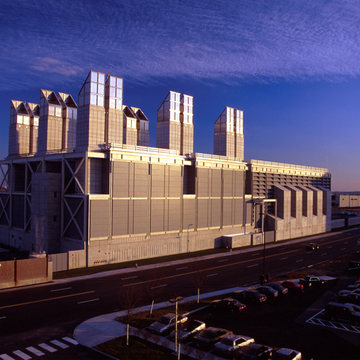An enormous configuration, the components of Ventilation Building No. 7 recall the monumentality of American grain elevators and engineering architecture that captivated leaders of the modern movement in the 1920s. Whereas the most advanced technology characterizes the Central Artery complex, this aboveground structure projects a powerful symbolic force, one enhanced by the fine proportions of its massing, and the rational expression of its functions. Huge chimney funnels consisting of two giant fans, exhaust and supply, specifically, draw stale air from the submerged roadway and replace this exhaust with fresh air drawn into the vent building through louvers in the long horizontal walls. The shutters serving as mechanical air intakes are part of the emergency response building. The Boston Society of Architects (1997) and the American Institute of Architects (1998) bestowed design excellence awards to the architects for this building.
You are here
Ventilation Building No. 7, Ted Williams Tunnel
1997 preliminary design, Stull and Lee and Wallace Floyd Associates; final design, TAMS. Harborside Dr.
If SAH Archipedia has been useful to you, please consider supporting it.
SAH Archipedia tells the story of the United States through its buildings, landscapes, and cities. This freely available resource empowers the public with authoritative knowledge that deepens their understanding and appreciation of the built environment. But the Society of Architectural Historians, which created SAH Archipedia with University of Virginia Press, needs your support to maintain the high-caliber research, writing, photography, cartography, editing, design, and programming that make SAH Archipedia a trusted online resource available to all who value the history of place, heritage tourism, and learning.















